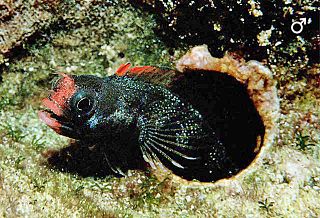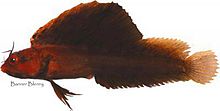
Threefin or triplefin blennies are blenniiforms, small percomorph marine fish of the family Tripterygiidae. Found in tropical and temperate waters of the Atlantic, Pacific and Indian Oceans, the family contains about 150 species in 30 genera. The family name derives from the Greek tripteros meaning "with three wings".

Blenny is a common name for many types of fish, including several families of percomorph marine, brackish, and some freshwater fish sharing similar morphology and behaviour. Six families are considered "true blennies", grouped under the order Blenniiformes; its members are referred to as blenniiformids. About 151 genera and nearly 900 species have been described within the order. The order was formerly classified as a suborder of the Perciformes but the 5th Edition of Fishes of the World divided the Perciformes into a number of new orders and the Blenniiformes were placed in the percomorph clade Ovalentaria alongside the such taxa as Cichliformes, Mugiliformes and Gobiesociformes.

The sarcastic fringehead is a small but very hardy saltwater fish that possesses a large mouth and aggressive territorial behavior, for which it has been given its common name.

Acanthemblemaria is a genus of chaenopsid blennies native to the Atlantic and Pacific Oceans.

The browncheek blenny is a species of chaenopsid blenny found in coral reefs in the Gulf of California, in the eastern central Pacific ocean. It can reach a maximum length of 6 cm (2.4 in) TL. This species feeds primarily on zooplankton. The identity of the person honoured in the specific name of this specie was not specified but it is thought to be the explorer and philanthropist Charles Templeton Crocker (1884-1948).

Acanthemblemaria hancocki, Hancock's blenny, is a species of chaenopsid blenny found in coral reefs around Costa Rica and Panama, in the eastern central Pacific ocean. and can reach a maximum length of 4.5 cm (1.8 in) TL. This species feeds primarily on zooplankton. The specific name honours the leader of the expedition on which the type was collected, the oil magnate and philanthropist Captain George Allan Hancock (1875-1965).

Acanthemblemaria maria, the secretary blenny, is a species of chaenopsid blenny found in shallow seas in the western central Atlantic Ocean and the Caribbean Sea. It can reach a maximum length of 5 cm (2.0 in) TL.

Acanthemblemaria rivasi, the spotjaw blenny, is a species of chaenopsid blenny found in coral reefs off Colombia and Costa Rica, in the western Atlantic Ocean. The specific name is an eponym but the individual it honours has not been identified, but it is possibly Luis R. Rivas of the University of Miami who is known to have lent specimens to Stephens.

Acanthemblemaria stephensi, the Malpelo barnacle blenny, is a species of chaenopsid blenny found in coral reefs around Malpelo Island, in the eastern Pacific ocean. It can reach a maximum total length of 5 cm (2.0 in). This species feeds primarily on zooplankton. The specific name honours the environmental biologist John S. Stephens Jr.
Coralliozetus rosenblatti, the spikefin blenny, is a species of chaenopsid blenny found in coral reefs in the eastern central Pacific ocean. It can reach a maximum length of 3.5 centimetres (1.4 in) TL. This species feeds primarily on zooplankton. The specific name honours the ichthyologist Richard H. Rosenblatt (1930-2014) of the Scripps Institution of Oceanography.
Emblemaria caldwelli, the Caribbean blenny, is a species of chaenopsid blenny found in coral reefs around the Bahamas, Belize, Honduras and Jamaica, in the western central Atlantic ocean. The specific name honours David K. Caldwell, Director of Marineland Research Laboratory, St. Augustine, Florida in gratitude for the loan of specimens.
Emblemariopsis bottomei, the shorthead blenny or the midnight blenny, is a species of chaenopsid blenny found in coral reefs in the western central Atlantic ocean. It can reach a maximum length of 3 centimetres (1.2 in) SL. The specific name honours Peter Bottome, although who this is, is not specified but it may possibly be the Venezuelan businessman Peter Bottome Deery (1937-2016).
Emblemariopsis dianae, the orangeflag blenny, is a species of chaenopsid blenny found in coral reefs around Belize, in the western central Atlantic ocean. It can reach a maximum length of 2.1 centimetres (0.83 in) fish measurement. The specific name honours Diane M. Tyler, a researcher into the behavioural ecology of blennies in the family Chaenopsidae and the wife of James Chase Tyler.

Emblemariopsis diaphana, the glass blenny, is a species of chaenopsid blenny found in coral reefs in the Florida Keys, USA, in the western central Atlantic ocean. It can reach a maximum length of 4 centimetres (1.6 in) TL. The specific name refers to this species being "largely translucent" in life, although this is lost in preserved specimens. E. diaphana is the type species of the genus Emblemariopsis.
Emblemariopsis pricei, the seafan blenny, is a species of chaenopsid blenny found in Glover's Reef, on the coasts of Belize and Honduras, in the western Atlantic ocean. It can reach a maximum length of 2.9 centimetres (1.1 in) SL. The specific name honours the premier of Belize at the time Greenfield was give permission to collect specimens in Bleize, George C. Price (1919-2011).
Emblemariopsis ramirezi is a species of chaenopsid blenny known from Venezuela, in the western central Atlantic ocean. The specific name honours Humberto Ramirez, who found this species and drew Cervigón's attention to it.
Emblemariopsis randalli, the hornless blenny, is a species of chaenopsid blenny found in coral reefs around Cubagua, Venezuela, in the western central Atlantic ocean. It can reach a maximum length of 3.8 centimetres (1.5 in) TL. This species feeds primarily on zooplankton. The specific name honours the ichthyologist John Ernest Randall who collected the type specimens and provided them to Fernando Cervigón for him to describe.
Emblemariopsis ruetzleri is a species of chaenopsid blenny found around Belize, in the western central Atlantic ocean. The specific name honours Klaus Ruetzler, Curator of Invertebrate Zoology at the National Museum of Natural History.
Neoclinus stephensae, the yellowfin fringehead, is a species of chaenopsid blenny found in the eastern Pacific ocean. It can reach a maximum length of 10 centimetres (3.9 in) TL. The specific name honours the collector of the type, the British-American conchologist Kate Stephens who was Curator of Mollusks and Marine Invertebrates at San Diego Natural History Museum and who was over 100 years old at the time the species was described.
Stathmonotus stahli, the eelgrass blenny or the seagrass blenny, is a species of chaenopsid blenny found in coral reefs in the western Atlantic ocean. It can reach a maximum length of 4 centimetres (1.6 in) TL. The specific name honours the Puerto Rican physician and biologist Agustín Stahl (1842-1917).










